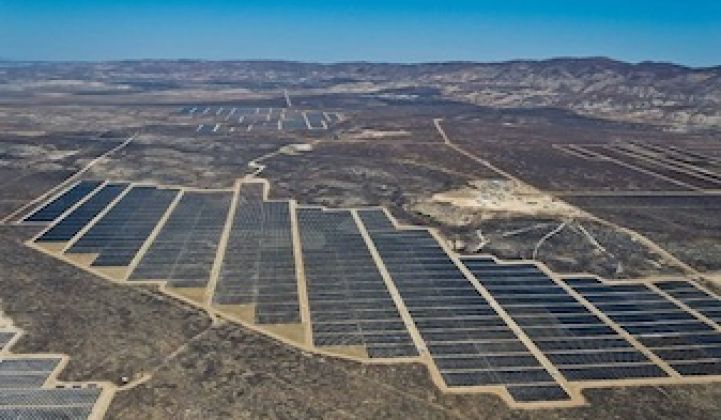One of the most misunderstood aspects of the solar PV phenomenon over the past five years is the notion that it has been driven entirely by surplus capacity from China and little else. Defenders of fossil fuel generation will say that the cost reductions are a mirage and that solar module prices will likely rebound as the market comes into balance.
They are in for a nasty shock. Between 2007 and 2012, solar manufacturing costs fell by an estimated 70 percent to 80 percent, largely as a result of the feed-in tariffs that began in Germany and spread elsewhere and the manufacturing boom that followed, particularly in China.
But the cost reduction was not simply a matter of capacity -- it was also about efficiency: more powerful modules, less silicon, less metals, improved manufacturing processes, and other factors. And the downward trajectory in price is continuing.
Last week, SunPower, the second largest U.S. PV manufacturer, said it had succeeded in reducing manufacturing costs by 20 percent over 2013, following a similar price drop a year earlier (and the year before that). It also managed to achieve an even bigger 25 percent price drop in balance-of-systems costs.
The latest cost decrease has been significant for SunPower, because it means the company can lift its margins from slightly negative to nearly 20 percent and deliver a solid return to shareholders. Further cost cuts means it will either improve its margins, and therefore its returns to shareholders, or be able to meet price drops in the consumer space if another surge in capacity emerges.
These are the signs of a sustainable industry. More importantly, they highlight the cost reductions that can be achieved by deployment at large scale.
SunPower president and CEO Tom Werner says the cost reductions are not over yet. He told analysts last week that the company's next manufacturing plant will likely reduce the cost per watt by a further 35 percent over its current manufacturing lines.
And there will be increases in efficiencies -- the new manufacturing plant (known as Fab 4) will enable SunPower to to drive higher cell efficiencies, and it plans to produce its first 23-percent-efficient X-Series panel by the end of 2015.
The 24 percent reduction in utility-scale deployment costs is also critical. SunPower had deployed a 1-megawatt module that it dubbed Oasis as the basis for its large-scale plants, which include the 250-megawatt California Valley Solar Ranch and the 579-megawatt Solar Star project the company is building for Warren Buffett’s MidAmerican Holdings.
However, Oasis has now been scaled up to a 1.5-megawatt module block, which can be replicated on any site. This improves installment efficiency because the block is pre-engineered and partially pre-fabricated, and the mounting structures are optimized so less steel is used.
There are other cost reductions in the pipeline. SunPower recently purchased a small California-based robotics engineering company called Greenbotics. This will enable it to cut water usage for cleaning by around 90 percent and lift its energy production at the same time. This will be key in hot and dusty markets such as the Middle East, South Africa and Chile.
“We believe that SunPower’s ability to directly attack cost across the entire value chain represents an important source of long-term competitive advantage,” Werner said.
Two other areas which will be crucial in future deployment are storage and finance. SunPower says the integration of energy storage into its products is a major focus, and it is implementing a number of pilot programs in this domain. More details will be released later this year.
Finance is also critical, and SunPower has now attracted more than $1 billion in third-party finance to offer home leasing, which forms the major part of the market in the U.S. and a growing component elsewhere. “We’ve also seen the cost of financing going down,” Werner said. “For instance, the [$220 million Bank of America] deal that we just [completed] has a lower cost of tax equity than our first deal did. So, that competition is working; it’s driving down the overall costs.”
Meanwhile, SunPower’s C-7 concentrated solar PV technology is also emerging into the commercial arena, and the company recently signed a contract to provide a 20-megawatt array for a data center, as well as entering a joint venture for the technology in China. Werner says the concentration factor will improve as the company introduces its higher-efficiency cells. “It has the potential to be very cost-effective, and it has the virtue of utilizing our [manufacturing] output very efficiently. It’s economically competitive and…it’s faster to scale.”
SunPower is also about to begin construction of a 70-megawatt merchant power project in Chile, a country with surging demand, insufficient capacity and, as a result, high wholesale electricity prices. It also has the best solar resources in the world, and SunPower’s array will be the biggest solar installation that will compete with other technologies on the open market.
***
Editor's note: This article is reposted from RenewEconomy. Author credit goes to Giles Parkinson.



